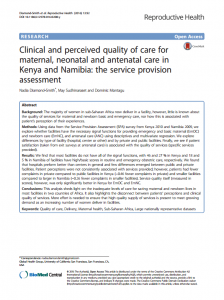
Background
The majority of women in sub-Saharan Africa now deliver in a facility, however, little is known about the quality of services for maternal and newborn basic and emergency care, nor how this is associated with patient’s perception of their experiences.
Methods
Using data from the Service Provision Assessment (SPA) survey from Kenya 2010 and Namibia 2009, we explore whether facilities have the necessary signal functions for providing emergency and basic maternal (EmOC) and newborn care (EmNC), and antenatal care (ANC) using descriptives and multivariate regression. We explore differences by type of facility (hospital, center or other) and by private and public facilities. Finally, we see if patient satisfaction (taken from exit surveys at antenatal care) is associated with the quality of services (specific services provided).
Results
We find that most facilities do not have all of the signal functions, with 46 and 27 % in Kenya and 18 and 5 % in Namibia of facilities have high/basic scores in routine and emergency obstetric care, respectively. We found that hospitals preform better than centers in general and few differences emerged between public and private facilities. Patient perceptions were not consistently associated with services provided; however, patients had fewer complaints in private compared to public facilities in Kenya (−0.46 fewer complaints in private) and smaller facilities compared to larger in Namibia (−0.26 fewer complaints in smaller facilities). Service quality itself (measured in scores), however, was only significantly better in Kenya for EmOC and EmNC.
Conclusions
This analysis sheds light on the inadequate levels of care for saving maternal and newborn lives in most facilities in two countries of Africa. It also highlights the disconnect between patients’ perceptions and clinical quality of services. More effort is needed to ensure that high quality supply of services is present to meet growing demand as an increasing number of women deliver in facilities.